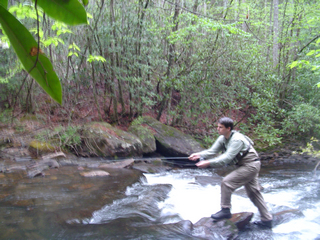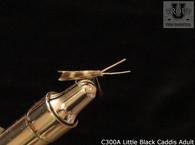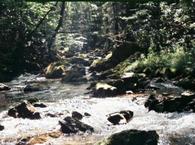
In this class, the student will learn from a master, why trout need special places, how to read surface currents, and the effects of rocks in a stream. After completion of this course, the student will be able to size up a stream and spot the more productive areas to cast. This class is an excerpt from Tom Rosenbauer's book "Orvis Guide to Prospecting for Trout "
SOME WATER that is easily fished during a hatch is tough to blind-fish with consistent success. Stream reading is a vital skill for prospecting, but you should approach a day of fishing with the philosophy that not all places in a stream hold trout, and others that may hold trout cannot be blind-fished easily.
When you cast to rising fish, you know exactly where each fish is, you have a good idea what they're eating, and you stalk one fish at a time. You know the fish are willing to feed, and if your casting is accurate you know they can see your fly. On the other hand, when blind-fishing, you must constantly keep two questions in mind: Can he see my fly, and can he see me? If he sees you before he sees your fly, the fish will be spooked, and even if he doesn't bolt for cover he won't be interested in eating. You must have confidence in your ability to locate unseen fish, and you must be able to make a decent presentation to the narrow range where a suspected fish can see your fly.

In general slow water is the hardest water to fish blind, for a number of reasons. Slow water is more difficult to read, because in big pools you don't have the benefit of differing currents to narrow the possibilities of where you may find a trout. In a riffle or run much of the water is too fast for a trout holding in place, and some of the water is also too shallow. Trout will be found in narrow, easily recognizable bands where fast water meets slow, deep water meets shallow, or rocks or shelves offer relief from the current. It is difficult to cover slow water without spooking the fish, because fish in slower currents get a much better look at the outside world and the food they're eating. In a riffle you can drop your line right on top of a trout without spooking him, so a thirty-foot drift will effectively cover thirty feet of water. In slow water, though, a thirty-foot drift will cover a maximum of fifteen feet, the length of the longest leader most of us can handle, and the trout lying under the fifteen feet of fly line will probably be spooked. Frankly most of us lack the patience to blind-fish slow water. The fly drifts so slowly that we lose interest and confidence in what we are doing.
You've seen fish rising in your favorite pool on another day when there was a good Sulphur hatch, so you know exactly where they are lying, right? Sorry. Those fish may be lying below the same spot you saw them rising, but in slow water, especially during a heavy hatch or spinner fall, trout often move from their normal lies into places where they can capture floating food with greater ease.

There are ways of finding trout in slow water, which we'll explore a little later in this chapter, and there are methods of fishing that work in slow water, which I'll talk about in later chapters. Vermont's Battenkill has miles of slow, deep water that I have tried to blind-fish with a nymph or dry during every month of the season, but I find myself spooking an entire pool before I can get a fish to look at my fly. Where a riffle punctuates the slow water, I'll do fine, but between the infrequent fast water I find myself relying on streamers, which can be fished independent of the current and for which trout will move from ten or even twenty feet away. On the other hand, when conditions are right in faster water, I can take trout on dries, wets, nymphs, or streamers.
So prospecting for trout relies heavily on riffles, runs, and pocket water, which is fine because in a heavily fished stream this is the water most fishermen ignore. When there are no hatches, I always start fishing at the head of a pool or run, in pocket water, or in a riffle, and then I graduate to the slower water if I can figure out what is going on. Fish in rough water are less easily disturbed, and they're also less wise to the dangers of artificial bugs. Trout fishing is supposed to be challenging, but I am quite content with the dumbest, least neurotic trout available if there is no hatch to even the odds.
Why Trout Need Special Places
When Thomas Jenkins built his artificial channel in Convict Creek, he found that different trout introduced into the channel separately used virtually the same feeding positions, even if a whole new group of trout replaced a previous group. The positions used didn't offer more food than the unused sites, but Jenkins thought the sites used offered better energetics — in other words, the fish could obtain their food without wasting more energy than they were gaining. Energetics is the basis of learning to read a stream. Trout need enough food passing by their position to have an almost constant supply, yet they need to lie in areas where the current velocity is nearly zero.
Bob Bachman has determined that brown trout prefer to lie in water with a speed from one-quarter to one-half foot per second and feed in water running about two feet per second. Rainbows generally feed in faster water, up to about six feet per second, while brook trout and cutthroats like about the same current speeds as browns. In a stream that offers all four species you'll often find the rainbows at the head of a pool and the other species in the middle and the tail of the pool, or in places where a large object slows the current. The current at the surface of a tumbling mountain stream might be ten feet per second, the fastest water in an average riffleand-pool lowland stream six feet per second, and the middle of a slow pool at low water approaching that magic half a foot per second. This is why you'll see trout hanging just below the surface in the middle or tail of a pool during a good hatch or spinner fall at low water — the current is slow enough that the fish can comfortably lie and feed in the same place.
The usual scenario, though, is for trout to lie in slower current and dart into faster current to grab a piece of food. A fish might lie behind a rock and move to the side, where food is washed around the rock. Another fish might lie on a rubble-strewn streambed and slide up into the faster water just above the bottom. The places to look for trout are areas where fast water meets slow, adjacent to the main current. How do trout find these places? One theory is that they "hear" a particular chord of sounds with their lateral line. Apparently every place in a stream has a unique sound fingerprint.
You can find the main current by watching the line of bubbles and debris that snakes its way through a pool or run. Look up to the head of a pool and find the fast water spilling into it, then trace its path through the pool to find the places where trout anchor themselves. Understanding stream richness will help you determine how close to the main current trout will be found — in an infertile stream they will be locked onto its edges like cars waiting on a highway entrance ramp. As richness increases they will be found farther and farther away, in the side streets and alleys.
Fishermen call these current-speed transition zones seams, and if you know nothing else about reading the water, you can find trout by looking for them. If you board a drift boat with a guide, the first thing he'll tell you is to hit the seams. Loosely defined, almost any place a trout feeds is a seam, because trout almost always lie in slow water and feed in faster adjacent currents. But seams formed by two currents of different direction and velocity are especially useful because they can help you find trout where there are no bottom obstructions to break the current, or where you can't see the obstruction on the bottom. When two currents meet, there is always a pocket of relative calm within the turbulence, and often it is enough to form a place where trout can lie and feed in comfort, even when there are no rocks, logs, or shelves. Seams like this form between the slow water next to a bank and the main current, below an island where currents re-form, or along the edges of a fast chute.
Less obvious than horizontal differences in current are the vertical ones. Anytime water encounters an object, friction slows the current and causes turbulence. Water that flows through a smooth pipe is nearly laminar, meaning most of the water molecules are running in the same direction. A trout stream never approaches anything near laminar flow, as the roughness of the streambed, the banks, and objects such as gravel bars and logs slow down the water, deflect the flow from a straight downstream course, and cause turbulence. That is why water in a straight piece of stream is fastest in the center of the river, near the surface. The closer to the banks and the bottom, the greater the friction, the greater the turbulence, and the slower the downstream progress of the water. Not surprisingly, then, in a stream of reasonable velocity without midstream obstructions you find most trout near the banks or on the bottom.
Reading Surface Currents
Reading the water is often spoken about as if it's some kind of voodoo that only grizzled old men who smoke pipes and have many patches on their waders understand. They are supposed to be able to make magic predictions by translating the fingerprints of surface currents into signs that point directly to trout. Stream reading skills do improve with experience, but no good stream reader depends entirely on surface currents; in fact you should only use surface currents if you have no other clues. As a bonefish guide on Christmas Island told me, "Don't look at the water, look into it, look through it." With a decent pair of polarized sunglasses and a little training — teaching your eyes what to look for — you'll be able to see deeper into the water. You'll also be able to spot trout on those rare occasions when they are visible. Don't think it takes vision like The Man of Steel's, either. It just takes experience learning what to look for. My eyesight has always been poor, and I wear strong contact lenses so that I can use polarized sunglasses and still take them off when it rains. A friend of mine, a commercial shell fisherman, can spot a flock of gulls wheeling over the water at least a half mile before I can, yet when we fish together I can spot trout and submerged rocks that he never sees. It's simply a matter of picking up patterns.
There are times, however, when you'll have to depend on reading surface currents: when the water is too dirty to see more than a foot into it; when glare that polarized sunglasses can't block obscures the water, especially in the morning and evening; or in a riffle where bubbles and surface turbulence hide what's underneath.
Midstream Rocks

Perhaps the most over-studied situation involves a submerged rock surrounded by either sand or gravel, so the rock stands out as an obvious trout haven in an otherwise unattractive spot. When water meets an immovable object, some of the water is stopped dead, and the kinetic energy it had is transformed into potential energy. Water gets potential energy by piling itself higher and gaining altitude, and you can see this at the head of a submerged rock. A bump in the water surface shows you where the rock begins; this bump is always slightly downstream of the rock because the current pushes it. It's a comfortable place for a trout to live because the current is slowed considerably, yet food is constantly pushed to him. Sometimes the force of the current digs a hole, giving the trout a place to bolt to when an osprey's shadow darkens the water.
When water rushes over a submerged object, an area of slower water forms just behind the object, and the difference in velocity causes turbulence. If the water is sufficiently shallow and fast, the turbulence carries to the surface and tells us where behind the rock the area of slower current is located. Trout like these places behind rocks, but not always and not everywhere. When you see standing waves or loads of foam behind a submerged rock, you may not find any trout directly behind it. The current's force is too great, the swirly turbulence may make it difficult for a trout to hold his position, and the unpredictability makes it hard for him to see and to intercept his prey. The current behind a large rock or boulder may be so slow that it offers little food. Only when the rock is no larger than a television set and the current moderate enough to form gentle swirls behind it are you likely to find a trout with his nose up against the rock.
Many more trout, and bigger ones, feed at the edges of the current that swirls around a rock and near the tail of the plume that extends downstream. I call the downstream end of the V-shaped plume, where it narrows to a point, the 'focal point,' and the focal point is usually the best spot of all for trout. Lying here, trout can feed from currents coming around both sides of the rock without fighting the violent turbulence that often forms just behind the rock.
 here the bump above a big rock will appear.
here the bump above a big rock will appear.Seldom do you find a single rock lying in a riffle or run like a spot on a clean mirror. Usually the mirror is covered with spots of all shapes and sizes, and if most of the bottom is covered with boulders and cobbles, fishermen call it 'pocket water.' This stuff is a blind-fisherman's delight: the trout here usually feed all day long. They are easy to approach, and they are not too picky about their fly selection. Stand off to the side and look for places where the focal point of one nice rock intersects the bump in front of another rock, or where a family of rocks form a minipool with its own bump, edges, and focal point. Because trout feed on drift that comes in front of the rock or slides off to the sides, I avoid dropping my fly in the swirly water right behind the rock, even though it's tempting to slam your first cast right there. Try it a couple of times and you'll see why it should be avoided — placing your fly there without dumping piles of slack into the leader will give you almost immediate drag, and a trout may be put off your fly on successive casts, even if they are drag-free. A trout that is lying around looking for food but not preoccupied with a hatch can be spooked much easier by a fly that drags than a trout that is filling his face with bugs. If you begin by placing your fly in front of the rock a few times and then try a drift along each side, it will be easier to get repeated drag-free floats. The water in these places runs uniformly downstream, so it's less likely that a squirrelly current will make your fly go south when the leader is heading north.
If you just can't resist plopping your fly in that gurgling mess right behind the rock, don't use a dead-drifted nymph or dry. Try a streamer, or a skating caddis or spider — something that laughs in the face of convoluted currents.
Exerpts from The Orvis Guide to Prospecting for Trout. by Tom Rosenbauer
Explore some of your favorite streams, put on some polarized sun glasses and observe trout and study their habits.
Recommended DVDs:
Fly Fishing for Trout in Tailwaters
Fly Fishing Strategies That Catch Trout
Read the The Orvis Guide to Prospecting for Trout.
Note: Class material has appeared in MidCurrents.





